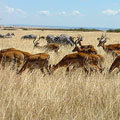Population Ecology
Editor(s):
|
Over twenty-five percent of all amphibians are in serious danger of going extinct. Why are some species more vulnerable to extinction than others? How can current rates of individual survival and reproduction be projected into the future? The Earth’s human population has doubled in less than fifty years, and will reach seven billion in 2011. What challenges do we face with this unprecedented growth? What factors might most effect the rates of this growth into the future?
Population ecology is the study of these and other questions about what factors affect population and how and why a population changes over time. Population ecology has its deepest historic roots, and its richest development, in the study of population growth, regulation, and dynamics, or demography. Human population growth serves as an important model for population ecologists, and is one of the most important environmental issues of the twenty-first century. But all populations, from disease organisms to wild-harvested fish stocks and forest trees to the species in a successional series to laboratory fruit files and paramecia, have been the subject of basic and applied population biology.
An organism’s life history is a record of major events relating to its growth, development, reproduction, and survival. Life histories vary tremendously from one species to the next. Why all the variation? For example, why do some organisms die immediately after reproducing (some salmon and bamboos, many insects, and all grain crops), while others live on to reproduce repeatedly (most plants and vertebrates)?
The study of population ecology includes understanding, explaining, and predicting species distributions. Why do species inhabit particular areas, and how are they prevented from establishing beyond their range limits? Such range questions have become popular in the last decade or so in response to concerns about climate change.
To develop a rich understanding of population ecology, begin with this introductory overview, and then explore the other summaries you’ll find below.
Population ecology is the study of these and other questions about what factors affect population and how and why a population changes over time. Population ecology has its deepest historic roots, and its richest development, in the study of population growth, regulation, and dynamics, or demography. Human population growth serves as an important model for population ecologists, and is one of the most important environmental issues of the twenty-first century. But all populations, from disease organisms to wild-harvested fish stocks and forest trees to the species in a successional series to laboratory fruit files and paramecia, have been the subject of basic and applied population biology.
An organism’s life history is a record of major events relating to its growth, development, reproduction, and survival. Life histories vary tremendously from one species to the next. Why all the variation? For example, why do some organisms die immediately after reproducing (some salmon and bamboos, many insects, and all grain crops), while others live on to reproduce repeatedly (most plants and vertebrates)?
The study of population ecology includes understanding, explaining, and predicting species distributions. Why do species inhabit particular areas, and how are they prevented from establishing beyond their range limits? Such range questions have become popular in the last decade or so in response to concerns about climate change.
To develop a rich understanding of population ecology, begin with this introductory overview, and then explore the other summaries you’ll find below.
Explore This Subject
Basic














